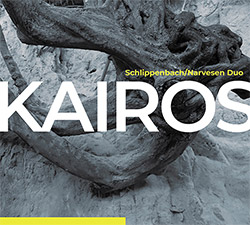
The piano-drum duet is hardly a new thing. The collaborations between James P. Johnson and Eddie Dougherty are over 80 years old and there have been plenty more since, with some pianists making it a bit of a calling card, such as Cecil Taylor and Irène Schweizer.
Alexander von Schlippenbach is also no stranger to the format, having been documented on record since the '70s with Sven-Åke Johansson, Paul Lovens, Tony Oxley, Eddie Prévost and Sunny Murray, and presumably playing live with some, if not many, others. His partnership with Norwegian Dag Magnus Narvesen — initiated after the German pianist was a guest in 2011 with the Kitchen Orchestra, of which Narvesen was part — has previously yielded two albums on another Polish label, Not Two.
What makes their intersection interesting — and what often invigorates free jazz encounters — is that Narvesen was born in 1983, nearly 20 years after Schlippenbach had made his first recordings in what has been one of the most important oeuvres in European jazz.
The pieces are all relatively short by free improvising standards and thus feel especially focused, Schlippenbach exploring distinct themes and motifs in each. His playing is full of space, Narvesen adding jittery clatter in the interstices, falling more on the coloration side of the rhythmic spectrum. The longest piece, "Tranquil Modality", coming around the middle of the 56-minute program, takes this approach to the extreme, as Narvesen's repartée is atomistic and gestural in response to Schlippenbach's delicacy, as if one extra cymbal tap would upend the titular mission. Contrast this with "Furiosa", which follows and where Narvesen feels liberated and unfettered yet still in control.
The one piece not created in situ is Schlippenbach's "Torso", originally heard on his 2019 Intakt solo date Slow Pieces for Aki. The duration is comparable and Schlippenbach's approach similar but Narvesen's oblique commentary plumbs deeper mysteries.
Comments and Feedback:



More Recent Reviews, Articles, and Interviews @ The Squid's Ear...


|

